By Peter Corne
TABLE OF CONTENTS
1. INTRODUCTION
2. ACQUISITIONS IN CHINA
2.1 Why Acquire Businesses In China? 2.2 How Are Businesses Acquired In China? 2.3 Asset Acquisition 2.4 Share Acquisition 2.5 Which method involves less risk? 2.6 What factors, apart from tax, can affect the choice of acquisition method? 2.7 What taxes are imposed on the sale? 2.8 Apart from the buyer and seller, who are the stakeholders in an acquisition? 2.9 What due diligence should be undertaken before an acquisition? 2.10 How should you deal with the valuation of a SOE? 2.11 Are there restrictions on payment of registered capital? 2.12 If using a joint venture form, which should be chosen? 2.13 What issues are involved when deciding whether to use an offshore or domestic PRC vehicle to make an acquisition?3. MERGERS
3.2 M&A Requirements 3.3 Approval Process4. DUE DILIGENCE
5. ANTICIPATING PROBLEMS
5.1 Dealing with state assets approval 5.2 Implications of excessively high valuation 5.3 What to do about secured assets 5.4 Incorporating a sales office network 5.5 Inventory and accounts receivable 5.6 Payment restrictions 5.7 Negotiating environmental requirements 5.8 Confidentiality & Intellectual Property Protection 5.9 WTO and the Impact on M&A in China6. CONCLUSION
1. INTRODUCTION
Foreign investors are increasingly looking to buy an interest in existing companies in China rather than set up a new business vehicle. The target companies may be domestic Chinese State-owned Enterprises (SOEs), existing Joint Ventures (JVs) or Wholly Foreign Owned Enterprises (WFOEs). Seeking entry into the China market through this route is not trouble free and investors need to consider carefully what they are seeking to achieve and whether this is the right route for them to take.
WTO accession will accelerate the development of China’s mergers and acquisitions ("M&A") market, and hopefully provide impetus toward further development and liberalisation of the legal regime supporting it. A mergers law has been on the cards for some time and it has been muted that approvals should be restricted to only those industries deemed sensitive in accordance with PRC industry policy. Investors would be wise to prepare themselves to take advantage of the rapid changes that now beckon.
The following provides a practical guide to M&A in China and highlights the difficulties that an investor may encounter.
2. ACQUISITIONS IN CHINA
2.1 Why Acquire Businesses In China?
Up until five years ago most of the laws in the PRC relating to foreign investment focused on the formation of foreign invested enterprises (FIEs). Indeed, foreign investment deals in their infancy tended to be formation projects where the parties funded a joint-venture company, built a new factory and imported machinery and equipment. Now, within the evolving PRC investment climate, foreign investors are increasingly looking to buy an interest in existing companies in China rather than set up a new business vehicle.
The regulatory environment in China is now more liberal than ever before, making this a good time to enter the market. China has a burgeoning private sector and revisions to the PRC Constitution have increased the status of private investment and will give private assets the same protection as state assets.
Local Governments are under pressure from Beijing to divest themselves of mid-sized and small SOEs as part of the on-going State reforms, making transactions easier to negotiate and complete. Businesses and assets are now available at lower prices; also tenders and public auctions offer some reasonably priced acquisition opportunities. China assets were out of favour following the International Trust and Investment Corporations (ITICs) crises; and as a result, vendors are more realistic about the selling price of State assets.
In addition to increased opportunities to acquire SOEs, many FIEs are now on the market for various reasons such as need for recapitalisation or retooling, or due to foreign partner difficulties at home. Acquiring an interest in a FIE can offer an interesting opportunity to gain access to an enterprise where many of the difficult tasks involved in setting up in China have already been undertaken.
The regulatory environment in China is now more liberal than ever before, making this a good time to enter the market. China has a burgeoning private sector and revisions to the PRC Constitution have increased the status of private investment and will give private assets the same protection as state assets.
Until recently the major issue preventing growth in M&A was an inadequate legal framework. Within a domestic context there was little pressure to develop rules specifically relating to M&A. However, a merger, division or acquisition of FIEs is much more complex than that of and between domestic companies. Any establishment, equity transfer or dissolution of a FIE involves special government approval as well as a series of other regulatory approval and registration requirements. As a result a number of laws have been promulgated that all contain M&A provisions giving force to the development of M&A in China.
2.2 How Are Businesses Acquired In China?
There are a number of ways to acquire a business in China which can be negotiated directly with a target shareholder or through an Assets and Equity Exchange. The most common methods are:
- direct acquisition of an equity interest in an FIE or domestic Chinese company
- acquisition of the assets of an enterprise, and injection into a new vehicle
It is also possible to indirectly acquire an equity interest in a FIE. This can be done by purchasing all of the shares in an offshore company that has as its only asset, the interest in the FIE. Thus, there is no need to go through any re-registration or re-approval procedures in the PRC.
Where PRC joint ventures include the injection as registered capital of the entire assets or plant of a PRC enterprise, it can also be seen as an acquisition as it resembles an exchange of shares in the joint venture for assets in the domestic Chinese company.
Another method of acquisition also exists, which is to acquire either H shares or B shares in a listed Chinese company (but not A shares which are currently restricted to Chinese nationals or legal person shares), or "red chip" shares in a China based company listed overseas. The attraction of this method of acquisition for foreign investors seeking majority control is diminished by limitations on majority foreign shareholding in such companies.
2.3 Asset Acquisition
The diagram below shows the procedure for the total assumption of a domestic party’s assets through a combination of contribution as equity and sale of assets to a joint venture referred to above.
(A) Total Assumption of a Domestic Party’s Assets
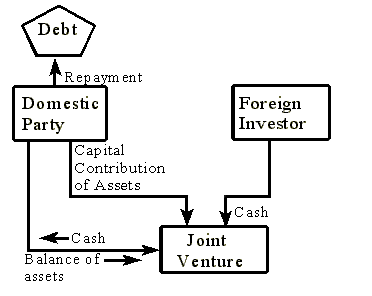
In this scenario, the Chinese party contributes part of its assets to the joint venture as registered capital in addition to selling the remainder for cash. The Chinese party uses the proceeds of the assets sale to pay off outstanding debt.
The diagram below shows an asset acquisition of assets by a foreign-owned vehicle funded from proceeds of the foreign investor’s cash injection. The proceeds of the acquisition again are used by the Chinese party to pay off debt.
(B) Asset Acquisition of Assets
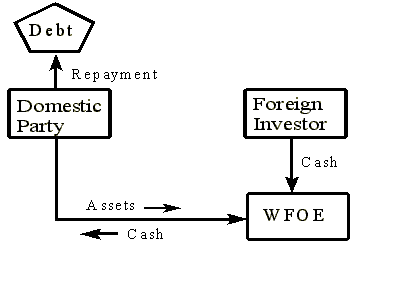
The diagram below shows the procedure for an assets for equity swap through a foreign invested vehicle with cash injection by a foreign investor.
(C) Assets for Equity Swap
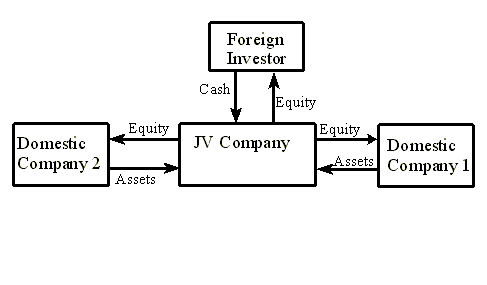
Recently, the PRC Government has started to allow, in limited cases, the JV company in such deals to be set up as a FIE company limited by shares, which gives the major shareholder control over all company decisions. This contrasts with the traditional joint venture form in which the minority shareholder has the right of veto over major business decisions such as merger, share transfer and liquidation.
2.4 Share Acquisition
It is also possible to acquire an interest in a SOE and then convert the enterprise into a joint venture company. The diagram below illustrates the procedure for this form of investment.
(D) Converting SOEs to JVs
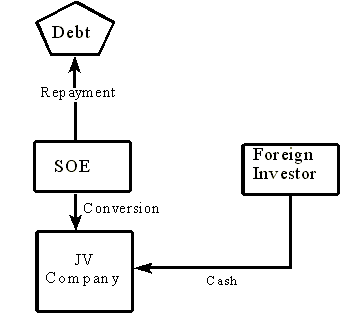
It is also possible for a foreign investor, through its China subsidiary, to acquire a SOE, either by acquiring all its shares or all of its assets (the latter being the safer and easier strategy). In order to become a branch of a FIE the SOE will have to first convert to a limited liability company in order to be in a form capable of a share sale. As SOEs are not companies organised under the PRC Company law, they are incapable of offering shares to non-state entities. The diagram below sets out the necessary steps.
(E) Converting SOEs to Companies Limited by Shares
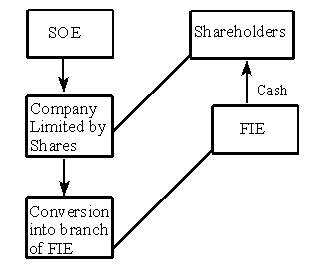
2.5 Which method involves less risk?
An assets acquisition with injection of such assets into a new vehicle always involves less risk because:
- bad and other debts are left behind as the assets are injected into a clean entity
- there is no automatic take over of SOE liabilities, for example the entire work force
- the foreign investor will have an opportunity to "cherry-pick" assets
A foreign investor cannot derive the same degree of comfort in an equity acquisition of a SOE because:
- SOE’s are generally sold "as is" with all liabilities included, and it is difficult to get an agreement on off loading of debts
- "triangular" debts, amongst SOEs are very common. This is where there are a series of interrelated debts whereby the ability of a debtor to pay its creditors is dependent on a payment from another creditor.
- SOEs were not designed to run on a commercial basis, but instead to meet state planning objectives
- the accounting system of many SOEs is still not transparent and cannot be relied on; political and financial pressures to sell may lead to exaggeration of figures
- sellers may not disclose all liabilities to legal due diligence teams in case they put buyers off, and
- it may be difficult in the PRC to get compensation from sellers for failure to disclose – there is little chance of recovering from an insolvent vendor and warranties or indemnities may be difficult to enforce in the PRC Courts
2.6 What factors, apart from tax, can affect the choice of acquisition method?
Foreign investment guidelines - The latest guidelines are contained in the 1998 Investment Catalogue, which sets out the permitted, restricted and prohibited industries. These may rule out reorganisation into a WFOE by requiring a FIE in a particular industry to be in the form of a joint venture. The guidelines also state that, in certain circumstances, over 50% of the interest must be held by the Chinese party. For example, retail FIEs in the coastal regions are required to be in the form of a joint venture with majority holding by the Chinese parties except under certain circumstances. It also states that any FIE involved in real estate or property development needs to have a stake (even if only a nominal interest) held by a Chinese Party.
(A) Debt- the level of actual and suspected debt of the target enterprise may necessitate an asset rather than an equity sale to reduce risk to acceptable levels. It may be possible to agree with the vendor to leave behind certain employees to reduce liabilities and to pick and choose the inventory to be taken on.
(B) Cost - It may be cheaper to form a joint venture using the assets for equity swap method rather than by a direct assets sale. The FIE legal framework is better established than for M&A.
(C) Approval - It may be difficult to get approval for a 100% asset or equity sale of a SOE. It is sometimes easier to form a JV first with a pre-agreement to convert to a WFOE later; however, it may be difficult to enforce such an agreement against the Chinese Party later.
2.7 What taxes are imposed on the sale?
Capital gains tax is imposed on a domestic seller for the sale of a stake in an enterprise. The relevant rates are 35%, 10-55%, and 30% in respect of disposals of a stake by a private enterprise, SOE and FIE respectively. Where the seller is a foreign entity, withholding tax of either 10% or 20% is imposed depending on the applicable region in which the enterprise is located and the relevant tax treaty.
Business tax of 5% is imposed on immovable property and intangible assets if there is an assets sale, or at a rate of 5% on the portion of equity attributable to the intangible assets or immovable property if it is a sale of interest in registered capital.
In addition, deed tax ranging between 3% to 5% depending on the applicable region is imposed on a transfer of immovable property as part of an assets sale and stamp tax may be imposed at 0.05% on a share (or equity interest) transfer and at 0.03% on an assets transfer.
There may also be tax issues for an overseas vendor, in their home country, relating to the proceeds of sale.
2.8 Apart from the buyer and seller, who are the stakeholders in an acquisition?
In an acquisition in China, it may not be obvious at the outset who the real stakeholders are. The interests of the following need to be assessed early on and thoroughly addressed:
- banks and other creditors
- owner of the SOE (relevant local Government)
- department in charge of SOE
- State Assets Bureau (in relation to a SOE)
- large customers such as distributors /sales agents / material suppliers, network operators (such as in telecommunications or power industry)
- Ministry of Foreign Trade and Economic Co-operation (MOFTEC) and/or Commission of Foreign Trade and Economic Co-operation (COFTEC)
- State Administration of Industry and Commerce (SAIC) and/or Administration of Industry and Commerce (AIC)
- Planning Commission
- State Asset Bureau valuers
- Environmental Bureau
- Land Bureau
- Tax Bureau/Customs (for imported items and customs duty exemption)
- State Administration of Foreign Exchange (SAFE) (where foreign debts are involved)
2.9 What due diligence should be undertaken before an acquisition?
Due diligence in the PRC can be complicated and time consuming, but it is essential and the extent (and therefore cost) of the due diligence investigation should be subject to a cost benefit analysis.
A due diligence team should comprise:
- lawyers
- accountants
- valuers
- environmental assessors
Many domestic Chinese firms are not familiar with the concept of due diligence and will be suspicious of the purchaser’s motives in insisting on full disclosure before signing up to an agreement.
2.10 How should you deal with the valuation of a SOE?
Where state assets are involved, a valuer that appears on an ‘A’ list as licensed by the State Assets Administration Bureau (SAAB) must be used. An international valuer should also be engaged to co-operate with the Chinese valuer to minimise the risk of an unrealistic valuation and to serve as a useful benchmark against which the state assets valuer’s valuation can be measured item by item.
After the valuation is concluded and approved by the SAAB, the actual transfer price may be reduced up to 10% without obtaining further SAAB approval.
Note that where negotiated through an Assets and Equities Exchange, state assets valuations can reportedly be negotiated downwards by up to 90%.
2.11 Are there restrictions on payment of registered capital?
The basic rule is that payment, if by lump sum, should be within six months of the issue of the new or amended business licence of the company. If the contribution is to be paid by instalment, 15% of registered capital must be paid within three months of the issue of the new or amended business licence, with the remainder contributed over a certain period of years depending on the size or nature of the project.
The basic rule has been modified by further rules that apply specifically to acquisitions, and they must, therefore be checked in detail.
2.12 If using a joint venture form, which should be chosen?
There are two basic forms of JV. Equity joint ventures are more popular with the Chinese Government, but offer no flexibility in terms of revenue sharing. Co-operative joint ventures (which may be limited or unlimited liability enterprises) leave scope for creative revenue sharing arrangements and for the foreign party to have greater management control than they would otherwise have. With co-operative joint ventures, there is the possibility of getting a return through depreciation, subject to giving book fixed assets at the end of the term.
As mentioned above for large acquisitions, a joint venture company limited by shares may be possible, especially if the foreign investor is perceived to be ‘saving’ an insolvent SOE from collapse. Note, however, that in such companies the minority party lacks any minority protection rights of veto, as in typical shareholders’ agreements in western jurisdictions.
2.13 What issues are involved when deciding whether to use an offshore or domestic PRC vehicle to make an acquisition?
A foreign investor will need to consider what impact an acquisition will have both on the buyer and the seller. Care will need be taken to ensure that tax benefits are not lost and a full assessment of likely tax treatment will need to be undertaken where the target is absorbed or merged with an onshore vehicle.
The investor will also need to ascertain whether the domestic PRC buyer is capable of legally purchasing the target and should consider the following points:
- there is a prohibition on use of registered capital (i.e. only accumulated profits can be used)
- the investor will need to be able to meet the requirement that the buyer cannot expend more than 50% of its net assets on the purchase
- there are equity holding limits in restricted industries
Consideration should be given to whether it would be worthwhile procedurally to acquire the target enterprise through a domestic vehicle rather than through an offshore vehicle. An offshore vehicle may allow disposal of shares in an offshore entity without triggering pre-emption rights to the non-transferring party. Tax reductions on disposal proceeds by offshore entities may be available under double taxation treaties. With an offshore vehicle, there is also the possibility of future spin offs and Initial Public Offering.
3. MERGERS
The merger of two JVs is possible under the PRC Company Law. The law sets out two forms of merger:
- Merger by absorption - where one company having been absorbed by a second is dissolved
- Merger by establishment - where two or more companies form a new company and the merged companies are dissolved. The diagram below illustrates this form of merger:
(A) Merger by Establishment between two FIEs
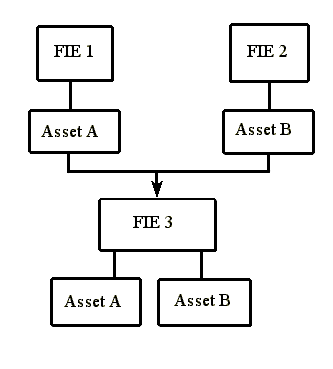
FIEs are technically able to merge with SOEs once they have been converted from being owned by the ‘whole people’ to being a limited liability company. A merger with a state owned company or a company in which the state is the controlling shareholder or holds certain equity interests, is subject to some stringent and complicated approval requirements in addition to procedures outlined in the Merger and Division of Foreign Invested Enterprise Provisions promulgated last year. Typically it will involve a state assets valuation, the approval of the department in charge of the state-owned or controlled company, and the approval of the State Economic and Trade Commission or its provincial commission. Thus, FIEs are unlikely to want to merge with a SOE preferring instead to acquire its assets in that way the company acquiring the assets gets to leave behind unwanted employees and is also able to "cherry pick". There have been few examples of mergers between FIEs and domestic PRC entities. The position regarding the new "merged" entity entitlement to tax holidays is unclear and the legal status of FIE/SOE mergers needs to be clarified. Regulations are more clear in the tax status of an FIE formed through merger of two FIEs.
3.2 M&A Requirements
Companies wishing to merge or acquire must fulfil a number of pre-requisites. The requirements are designed to eliminate the possibility of foreign investors using M&A as a means to achieving a result not permitted under existing foreign investment regulations or reward those that seek to avoid such laws. For example, those projects that have been split into smaller FIEs to avoid the time consuming central authority process will face the major hurdle of not being able to merge into one until they have completed their capital contribution and commenced actual operation – thus needing to go through central MOFTEC. In addition to the hurdles faced by FIEs, domestic enterprises also need to fulfil a lengthy and extensive set of pre-requisites. These pre-requisites coupled with those above combine to burden the parties in time consuming delays.
3.3 Approval Process
Although the approval procedures set out in the relevant regulations seem relatively straight forward, in practice they are, as above, time consuming and complicated involving preparation of lengthy application documents and multiple approval authorities. The approval process for a merger deal begins with the need to gain the approval to dissolve the original company. The process of dissolution is not a simple matter and though theoretically contained within a fifteen day approval period this is not necessarily complied with. This process gives the local government the opportunity to assess the possible effects of the merger on the local economy – especially in relation to employment and tax issues. After approval to dissolve, the applicant is required to submit the following documents in the preliminary approval stage:
- Application letter;
- Merger agreement;
- Board resolution of all merging companies;
- Approval certificates and business licences of all merging companies;
- Capital verification reports of all merging companies;
- Balance sheets and assets lists of all merging companies;
- Audited financial statements for the precedent year of all merging companies;
- List of creditors of all merging companies;
- New joint venture contract and articles of association of the merged company; and
- Any other document required by the competent authority.
The approval authority is required to give its decision within 45 days. However where the authority suspects that the merger may create a monopoly it will then hold hearings with relevant departments and organisations to determine whether the merger should be blocked or not. In such cases the approval period is extended to 180 days. The provisions here though not detailed outline the concern of the Chinese government at the prospect of foreign investors being able to achieve a monopoly status in certain industrial areas. Also of note, is the fact that Chinese competitors of FIEs will also often petition the authorities in respect of such issues.
After the preliminary approval stage has been granted the merging companies are required to notify their creditors and make a public announcement. Creditors have the right to request modification to the debt succession plan, immediate repayment of outstanding debts and/or provision of security. Provided that no objections are raised and creditor notification requests are met within 90 days of the public announcement the approval authority will grant the merged company its final approval.
4. DUE DILIGENCE
Due diligence investigation - what should be checked?
- type of enterprise (SOE, FIE, Joint Stock Company) and ownership structure and to check whether it is a "false" JV with Chinese-Chinese money
- licences and approvals (especially business licence and obvious breaches of this in its activities and scope) for equity
- constituent documents
- asset title certificates, especially land use rights and pledges charges and encumbrances over these and outstanding land use fees
- loans and guarantees made to or by the enterprise (shareholder loans)
- relevant taxes on the transaction and record of tax payments by target
- foreign exchange and foreign debts approvals/registration
- labour problems (double ten issues), trade unions, numbers of personnel/to be retained/fund
- environmental issues - obvious examples of confirmation/discharge/coveralls/long term supply
- contractual agreements and transactions on non-commercial terms
- litigation and arbitration
- danger/warning signs - willingness (or otherwise) to make full disclosure/co-operation with due diligence exercise/refusal to provide information known to exist
- bad/overdue/receivables, absolute unsaleable stock/machines
5. ANTICIPATING PROBLEMS
It is important to anticipate possible difficulties and to prepare well in advance. Set out below are some of the issues that should be considered:
5.1 Dealing with state assets approval
If state assets are being sold an official valuation by a State Assets Administration Bureau (SAAB) valuer must take place and the SAAB must endorse the final valuation. The state valuation invariably exceeds the expectations of the foreign purchaser and it is important to get a foreign valuer involved in the process and if possible, manage or at least monitor the State Assets Valuer. Do not leave the negotiation of value until after SAAB approval of the valuation. The sale price can still be negotiated down from the valuation price by 10% without SAAB approval of the reduction.
5.2 Implications of excessively high valuation
It is vital to obtain a valuation that is fair as an excessively high valuation will mean that the equity interest target cannot be met without the injection of extra unplanned capital. An increase in the value of the assets may result in the acquisition falling into the category of projects that require central Government approval which will invariably lead to delays and further expense.
5.3 What to do about secured assets
It is vital to conduct through due diligence and to check registries for secured assets. Mortgage releases should be obtained from the registries as a condition of the transaction. It is also necessary to check the status of unregistered and pre-1995 mortgages and the ownership of moveables and warranties.
5.4 Incorporating a sales office network
Existing sales networks of the Chinese partner are usually a mixture of entities such as solely owned and jointly owned vehicles. Sales entities’ staff are often not solely that of the target SOE, which may raise confidentiality and control issues. A JV cannot set up branches until registered capital is fully paid up. Consider either incorporating existing entities temporarily by way of a service agreement, with conversion into branches later when the JV is eligible, or reregistering existing sale entities as the JV liaison offices.
5.5 Inventory and accounts receivable
It is essential to check for problems of transferability, recoverability and substantiality of accounts receivable. Checks should also be made for hidden inventory, especially in the sales offices. If the foreign investor agrees to assist with the selling of unwanted finished products, it is advisable to set a time limit. The problems caused by an accumulated inventory should not be underestimated.
5.6 Payment restrictions
There are guidelines on time limits for instalment payments to registered capital. There is a six month time limit restriction on payment for assets acquired by the foreign investor directly from a Chinese seller, which is subsequently injected into a FIE as registered capital. Warranties and escrow accounts, though useful, have their limitations in China.
5.7 Negotiating environmental requirements
Some foreign investors have been successful in entering into environmental agreements with the environmental authorities which give them greater flexibility to comply with requirements. Improving the emissions of an existing plant to comply with standards may take time and it is a good idea to make a conservative estimate. It is important to be aware of preconditions for passing ‘construction project environmental protection facilities completion test’ before entering into ‘formal production’. Foreign investors should try to take advantage of the authority’s discretion to allow ‘trial production’ and incorporate this into the environmental agreement.
5.8 Confidentiality & Intellectual Property Protection
A foreign investor should insist upon a confidentiality undertaking from the Chinese side in respect of information that is disclosed during the negotiations. This is particularly important to ensure protection of the investors know how and trade secrets.
It is important that confidentiality obligations are also stated in the transfer agreement, and that filings for relevant intellectual property that may be licenced to the China entity are made prior to closing. To guard against leakage of confidential information, a system within the PRC company for safe-keeping should be devised. PRC courts have been known to deny claims for theft of trade secrets where no such systems have been put in place.
In consultation with legal advisors, a preventative strategy against counterfeiting should also be devised, which may, for example, include counterfeiting surveillance and enforcement strategies focusing on key markets.
5.9 WTO and the Impact on M&A in China
China’s investment environment has and is continuing to undergo a gradual albeit extensive transformation. The rules governing business relationships are becoming more settled and somewhat more sophisticated. However, despite the fact that the regulatory environment has progressed China is by no means a ‘shelf company’ styled jurisdiction, where foreign investors can set up business within hours or days with a minimum of dealings with governmental authorities – This is perhaps perfectly captured in the Merger Provisions where it can take up to 285 days simply to gain approval for companies to merge.
The M&A Laws now in place substantially improve PRC legislation concerning foreign investment at the very least they have laid down a basic regulatory framework for conducting M&A in the PRC. However, a number of fundamental problems still exist and the approval procedures remain rather onerous. A brief analysis of the laws shows the PRC government wanting to reform its SOEs and relax foreign investment rules albeit cautiously. It certainly can be said that the door to foreign invested M&A has opened, but not too wide.
For obvious reasons it has been muted that approvals should be restricted to only those industries deemed sensitive in accordance with PRC industry policy.
With China’s accession into the WTO approaching it has become a pressing issue for the Chinese government to clarify the rules on M&A involving foreign participants as further opening up to foreign investment will result in increased cross-border acquisitions, especially in restricted industries such as telecommunications, banking, internal and foreign trade, securities and distribution.
Indeed, WTO accession will accelerate the development of China’s M&A market, and hopefully provide impetus toward further development and liberalisation of the legal regime supporting it.
6. CONCLUSION
As the environment for foreign investment matures, and the major players, their suppliers and other companies become well established in the PRC, the market for M&A becomes more attractive. There are four main factors that have contributed to the development of this market to the extent that today, there is greater merger and acquisition activity in the PRC than at any other time in history. Those factors being:
- a more developed legal environment
- an increase in FIE targets (due in no small part to the Asian financial crisis causing the pull-out of Asian investors)
- SOE reform
- the emergence of private domestic companies as legitimate and viable targets
To find out more...
If you would like to know more about any of the matters covered in this document, please get in touch with us. The principal lawyers involved in our China practice include:
- Gary Lock
- Peter Corne
- Andrew Godwin
- Huen Wong
- Stephen Mok
- Daniel Liew
For further information, please contact us.
This article contains general information on the subject matter and shall not be relied upon for a specific case. Specialist advice should be sought with respect to any specific circumstances.
SIMMONS & SIMMONS - An International law firm
Hong Kong - London - Paris - Brussels - Lisbon - Milan - Rome - Abu Dhabi
